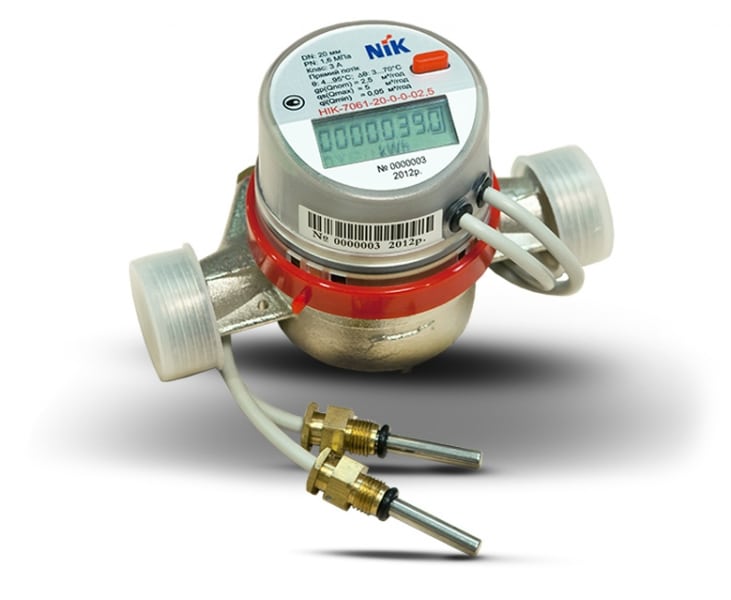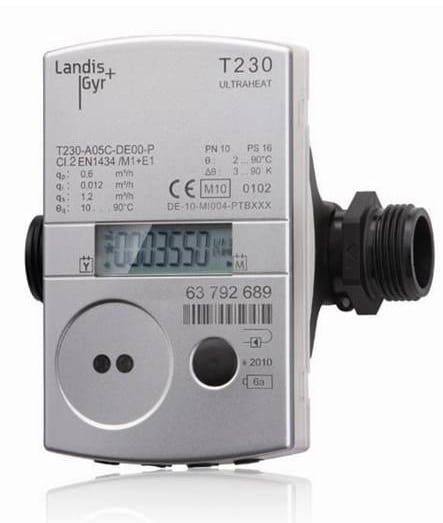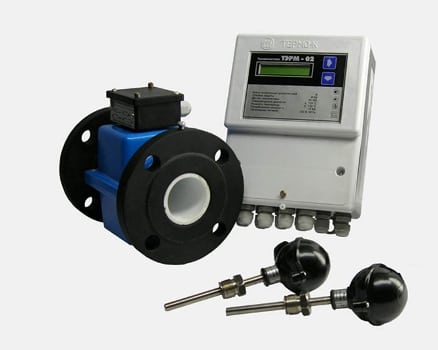Constantly rising heating tariffs are forcing apartment owners to look for ways to save heat costs. One of them is the installation of a heat meter. Thanks to him, the owner of the apartment can only pay for the heat that has entered his apartment. The utility companies will still increase the payment by some amount, which will be compensation for the heat used to heat the stairs and corridors of the house. However, in any case reduce the amount on the invoice.
What is a heat meter
A heat meter is a set of devices that calculate the amount of heat energy used, taking into account the amount of coolant supplied and the change in its temperature.
Each device includes:
- Temperature sensors.
- The counter of the amount of water, or rather the coolant that has passed through the pipes and radiators of the apartment.
- Calculator. Analyzes the data of the above elements and determines the amount of consumed heat. Often it is combined with a coolant meter. It always runs on electricity. You do not need to connect it to the mains, because it contains lithium batteries. They are designed for 7-10 years of work.
Two sensors are always used. One is placed at the inlet of the apartment heating system, the other at the outlet. The counter can be installed both at the input and at the output.
The easiest way to use a heat meter is in houses that have horizontal piping.
Such wiring provides. Thanks to this, it is easy to calculate the amount of coolant and the level of its cooling. In such situations, the heat meter consists of two sensors and the main device.
The situation with vertical piping is more complicated. It provides for the connection of apartment radiators to various vertical racks. According to legislative norms, it is impossible to install a heat meter in houses with such a wiring, because from a technical point of view it is almost impossible. In addition, there are huge difficulties: two heat sensors and a separate meter must be installed on each battery. That is, the heat meter will be a set of a large number of sensors and measuring devices. An additional problem is that in order to determine the total amount of heat, it is necessary to sum the readings from each meter.
Read also: Radiator valve
Principle of operation
The heat meter always determines and uses two indicators:
- The amount of coolant passed through the pipes.
- The change in the temperature of the coolant when passing through all the radiators of the apartment. It is determined by two sensors.
Combining these data, it determines the total amount of heat supplied to the apartment. The deduction is made according to the formula: Q \u003d c * m * (t 1 -t 2), where
- With is the specific heat capacity of the coolant (since water often plays its role, this indicator is unchanged and equals 4.187 kJ / kg * C °),
- m is a mass of water or other heated liquid,
- t1 And t2 are the temperature levels of the water passing through the supply and return pipes, respectively. The temperature unit is C°.
The unit of measure for the final figure is Gcal (gigacallorie).
The calculator receives all the data from the temperature sensors and the counter, performs calculations and records the final figure in the archive. You can see the saved results on the screen of the device or on the usual optical interface.
Types of heat meters
The battery heat meter is always classified according to the device that measures. Temperature sensors are the same everywhere.
The most commonly installed types of counting devices:
- Mechanical.
- Electromagnetic.
- Ultrasonic.
- Vortex.
Mechanical devices

Their main element is a part that can rotate when the coolant passes through the meter. At the same time, one of its revolutions corresponds to a certain amount of water passed. The device calculates the number of revolutions and determines the amount of coolant used. The final digits are passed to the calculator.
The rotating part is different, and therefore companies produce several classes of mechanical water meters. Most often, vane and turbine meters are used in heating networks. In the first part of rotation is an impeller, which is placed so that its axis is perpendicular to the water flow. Turbines contain a turbine. Manufacturers place it so that its axis and the flow of coolant are parallel.
Read also: What heat regulator can be put on the battery
Advantages of mechanical devices:
- Simple structure and reliable construction.
- No need for external electricity.
- Stability of indicators.
- Maintenance and installation are very easy. During the second process, a coarse mesh filter must be installed in front of the device. Otherwise, the accuracy of the device will drop.
- Possibility of installation in any position.
Minuses:
- Shorter shelf life than competitors.
- Protruding parts are heavily worn.
- Low sensitivity to a small amount of energy carrier.
Ultrasonic devices

Such heat meters for the battery determine the volume of the consumed coolant thanks to ultrasound. Their main part is a pipe through which water flows, and at the ends of which an ultrasound receiver and emitter are placed. During the flow of a heated liquid through a pipe, the emitter creates ultrasound, and the receiver picks it up.
The passage of ultrasound through the coolant takes some time. It is affected by the speed of the water. The larger it is, the longer the transit time of the ultrasonic signal becomes. The device determines the signal delay and calculates the amount of heat carrier used. Measurements are accurate when the water is clear. If there are many impurities and even air bubbles, a figure with a very strong deviation is displayed on the screen. Scale deposits also affect the measurement accuracy.
The following types of ultrasonic heat meters can be put on the battery:
- frequency device.
- Temporary.
- Doppler
- Correlation.
Electromagnetic heat meters

These devices determine the volume of the coolant by creating a magnetic field. When water passes through this field, an electric current appears in it. At the same time, the device determines the current voltage, which is closely related to the speed of the heated water. The higher the speed, the higher the voltage becomes. Knowing the flow rate, the device easily determines the volume of liquid.
The voltage is determined by two electrodes. They are placed at opposite ends of the magnetic field.
The electromagnetic meter can be installed on any battery of the system with horizontal piping.
Features of these devices:
- Very high level of accuracy.
- High sensitivity to the quality of installation. A small amount of current flows through the device. In order for this indicator to comply with the standards established by the manufacturer, it is necessary to make a high-quality connection of wires, eliminate the possibility of an external magnetic field and additional resistance at the places where the wires are fastened. Otherwise, the error of the final indicators will be high.
- Sensitivity to the quality of the coolant. If the water is rich in iron compounds, then the final figures become overestimated.
